2021 Summer NAMM - Booth Display Types & Regulations
NAMM generally follows the International Association of Exhibitions and Events (IAEE) guidelines for display rules and regulations. IAEE’s revised 2019 edition has been used as a resource to create consistent and fair exhibiting standards for the NAMM events.
NAMM intends to operate Summer NAMM as a cost-effective event that is moderately sized and held in a relaxed atmosphere. In keeping with this direction, NAMM is requesting that Exhibitors construct single-story displays only. Hanging signs or other items from the ceiling is prohibited.
The following display rules and regulations will be strictly enforced by the NAMM Floor Management Team.
Variance Requests
Only exhibits that do not comply with NAMM’s booth display rules and regulations must submit a booth variance request to NAMM no later than June 25, 2021. If you feel your booth space does not fit into one of these categories, please complete the Booth Variance Request Form.
- NAMM Management will review all submissions carefully and respond in writing
- NAMM reserves the right to require a structural engineer’s approval
- Approved variances are valid for the 2021 Summer NAMM Show only
- Variance requests will not be accepted on site
Small Booths
Linear Booth guidelines will apply to small booths.
- 6’ deep x 8’ wide = 48 square feet
- Includes black 8’ high draped back wall and 36” draped side rails to define the space
- Includes 4’ long x 30” high black-draped table
- Includes Company ID Sign
- Includes one chair
Tabletop Booth
Tabletop booths have only one side exposed to the aisle and are generally arranged in a series along a straight line.
- 6’ deep x 5’ wide = 30 square feet.
- Includes black 8’ high draped back wall and 36” draped side rails to define the space
- Includes 4’ long x 30” high black-draped table
- Includes Company ID Sign
- Includes one chair
Linear Booth
Linear booths, also called "inline" booths, are arranged in a straight line and usually have neighboring exhibitors on their immediate right and left, leaving only one side exposed to the aisle. Most commonly 10' (3.05 m.) wide and 10' (3.05 m.) deep, i.e., 10'x10' (3.05 m. by 3.05 m.).
- The maximum back wall height limitation is eight feet (8ft) (2.44m). Exception: Perimeter booths that are linear are allowed to have a twelve foot (12ft) (3.66m) back wall.
- Regardless of the number of linear booths utilized, e.g. 10'x20' (3.05 m. by 6.10 m.), 10'x30' (3.05 m. by 9.14 m.), 10'x40' (3.05 m. by 12.19 m.), etc. display materials must be arranged in such a manner so as not to obstruct sight lines (line-of-site rule) of neighboring exhibitors. The maximum height of 8' (2.44 m.) is allowed only in the rear half of the booth space (the back 5'), with a 4' (1.22m) height restriction imposed on all materials in the remaining space forward to the aisle.
- Hardwall booths must be a minimum of nine (9) inches from the back booth line for electrical access.
- Linear Booths include black 8’ high draped back wall and 36” draped side rails to define the space.
The diagram below is an example of what will be permitted for Linear Booth Construction.
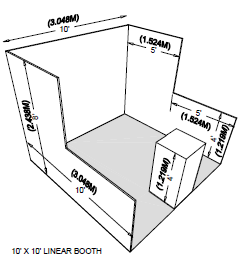
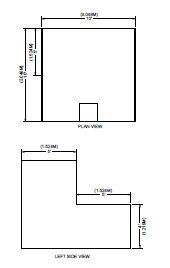
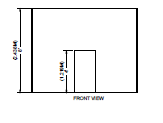
Corner Booth
A Corner Booth is a Linear Booth exposed to aisles on two (2) sides. All other guidelines for Linear Booths apply.
Perimeter Booth
A Perimeter Booth is a Linear Booth that backs to an outside wall of the exhibit facility rather than to another exhibit.
Booth Package: Includes black 8’ high draped back wall and 36” draped side rails, and 7” x 44” Company ID Sign.
- All guidelines for Linear Booths apply to Perimeter Booths except that the maximum back wall height is twelve feet (12ft) (3.66m).
- All fire equipment (hoses, extinguishers, strobe lights, speakers) must remain unobstructed and visible at all times.
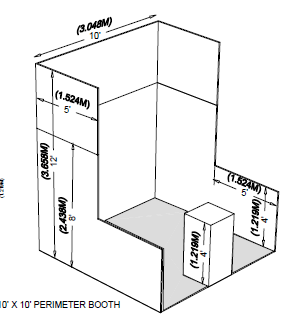
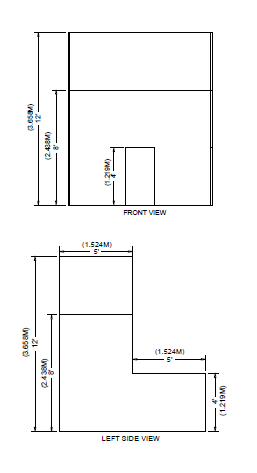
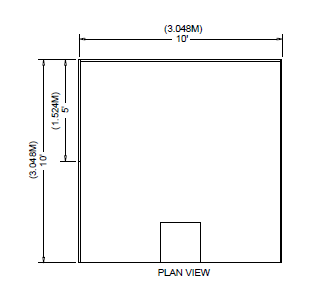
End-Cap Booth
An End-Cap configuration is an in-line (linear) booth placed in the position of a Peninsula or Split Island.
Booth Package: Includes 10 feet of black 8’ high draped back wall and 36” draped side rails, and 7” x 44” Company ID Sign
- End-cap booths are generally 10ft (3.05m) deep by 20ft (6.10m) wide. The maximum back wall height allowed is 8ft (2.44m) and the maximum back-wall width allowed is 10ft (3.05m) at the center of the back wall with a maximum 5ft (1.52m) height on the two side aisles. Within 5’ of the two side aisles, the maximum height for any display materials is 4’.
- Display materials must be arranged in such a manner so as not to obstruct sight lines (line-of-site rule) of neighboring exhibitors.
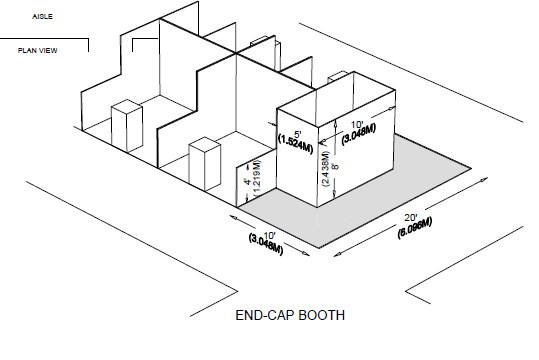
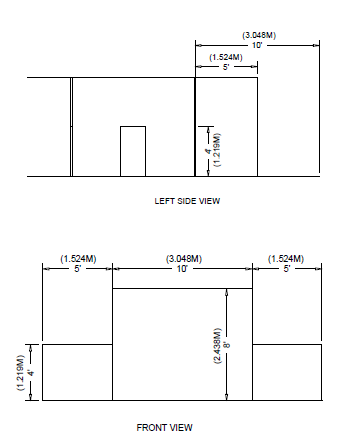
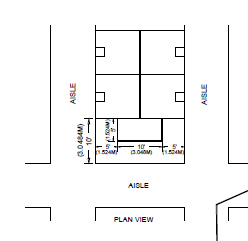
Peninsula Booth – Backed up to Linear Booth
Exposed to aisles on three (3) sides and is composed of a minimum of four 10’ x 10’ (3.05m x 3.05m) booths and backs up to Linear Booths.
Booth Package: Includes 10 feet of black back wall drape consisting of (2) 36” H x 5’W and 8’H x 10’W and 7” x 44” Company ID Sign
- A Peninsula Booth is usually a 20’ x 20’ (6.1m x 6.1m) or larger. When a Peninsula Booth backs up to two Linear Booths, the back wall is restricted to four feet (4ft) (1.22m) high within five feet (5ft) (1.52m) of each aisle, permitting adequate line-of-sight for the adjoining Linear Booths.
- Sixteen feet (16ft) (4.78m) is the maximum height allowance, including signage, for the center portion of the back wall. Double-sided signs, logos and graphics shall be set back ten feet (10ft) (3.05m) from adjacent booths.
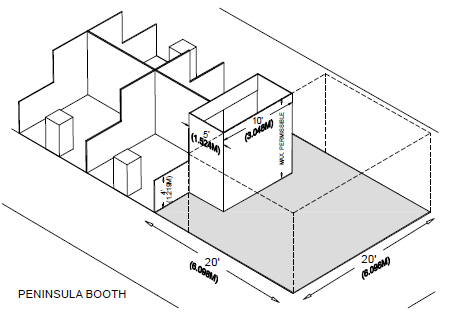
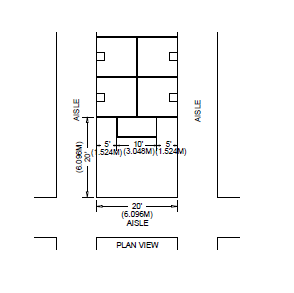
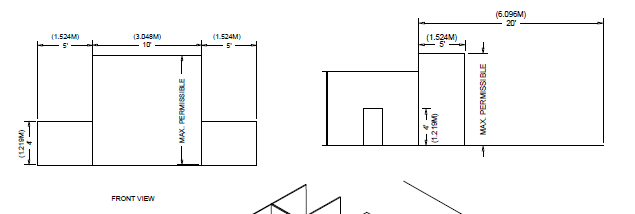
Split Island Peninsula Booth
A Split Island Booth is a Peninsula Booth that shares a common back wall with another Peninsula Booth.
Booth Package: Includes black 8’ high draped back wall, separating the adjoining peninsula booth.
- The entire cubic content may be used, without any back wall line-of-sight restrictions
- Sixteen feet (16ft) (4.87m) is the maximum height allowance, including ground, supported signage
- The common back wall must be finished with paint or drape and may not carry any branding or identification that would detract from the adjoining exhibit. All signs, branding and logos must be set back ten feet (10ft) (3.05m) from the adjoining booth
- Multi-Story booths are prohibited
- Hanging Signs are prohibited
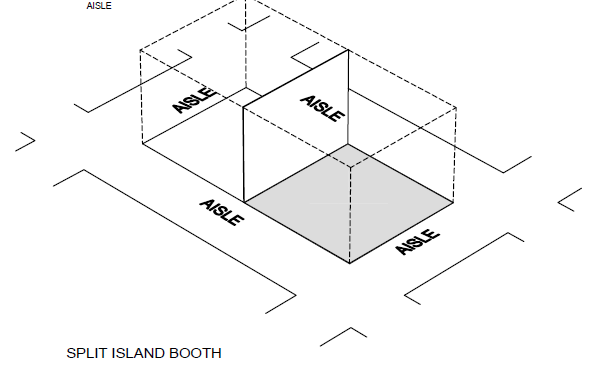
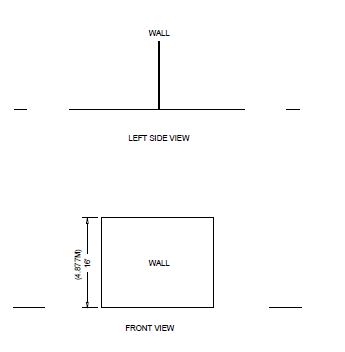
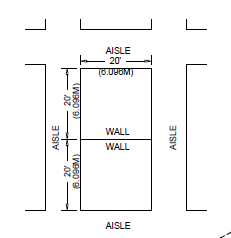
Island Booth
An Island Booth is any size booth exposed to aisles on all four sides.
- Sixteen feet (16ft) (4.87m) is the maximum height allowance, including ground, supported signage
- Multi-Story booths are prohibited
- Hanging Signs are prohibited
- Pipe and drape is not included

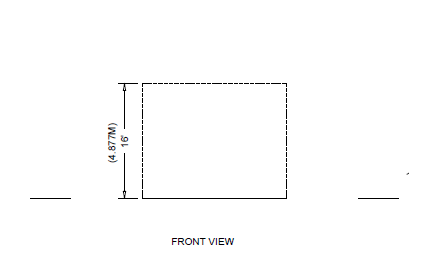
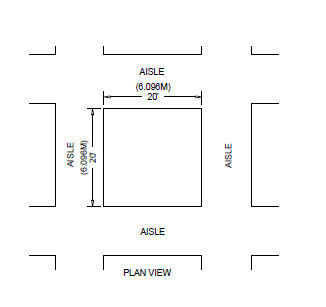
Extended Header Booth
Extended Header Booth is a Linear Booth twenty feet (20ft) (6.10m) or longer with a center extended header.
- All guidelines for Linear Booths apply to Extended Header Booths, except that the center extended header has a maximum height of 8ft (2.44m), a maximum width of 20 percent of the length of the booth, and a maximum depth of 9ft (2.7m) from the back wall.
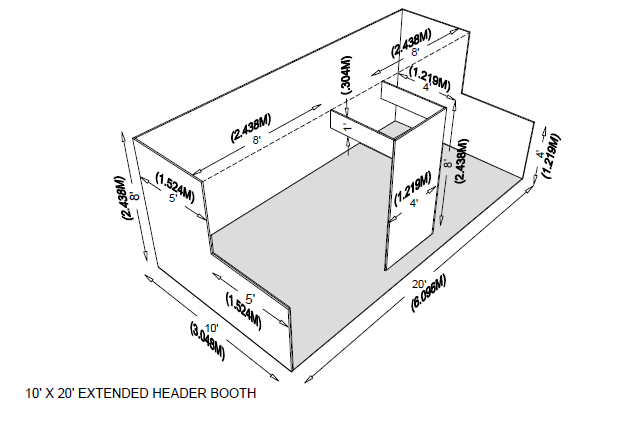
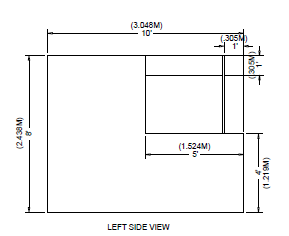
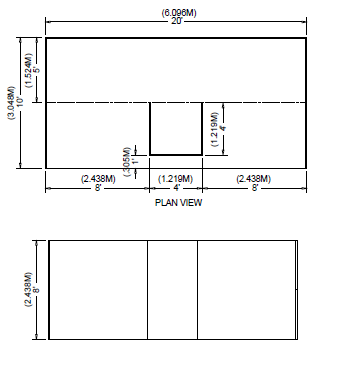
Canopies and Ceilings
Canopies, including ceilings, umbrellas and canopy frames, can be either decorative or functional (such as to shade computer monitors from ambient light or for hanging products). Canopies for Linear or Perimeter Booths must comply with line-of-sight requirements for Linear and Perimeter Booths.
- The base of the Canopy should not be lower than seven feet (7ft) (2.13m) from the floor within five feet (5ft) (1.52m) of any aisle. Canopy supports should be no wider than three inches (3in) (.08m). This applies to any booth configuration that has a line-of-site rule, such as Linear Booth.
- Exhibitors are cautioned when installing a display with a ceiling to check with the local fire department to ensure that display meets with the necessary fire safety precautions involving smoke alarms, fire extinguishers, sprinkler systems, etc. Smoke alarms will be required in any covered booth.
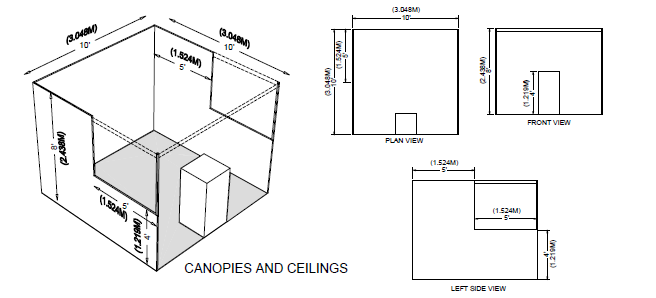
Tower
A Tower is a freestanding exhibit component separate from the main exhibit fixture.
- The height restriction is the same as that which applies to the appropriate exhibit configuration being used.
- Fire and safety regulations in many facilities strictly govern the use of towers.
- Submit drawings to NAMM for towers in excess of eight feet (8ft) (2.44m), as a building permit and safety/seismic lines may be required.
- All towers in excess of eight feet (8gt) (2.44m) must submit a request for a booth variance by June 25, 2021.
Theatrical Truss, Lighting, Speakers and Fixtures
- Exhibitors are cautioned when installing a display with trussing to comply with the permissible height corresponding to their booth configuration (for example, the highest point of any truss may not exceed the maximum allowable height for the booth type).
- NOTE: Ceiling supported truss hangs and hanging signs are not permitted
- No lighting, fixtures, lighting trusses or overhead lighting are allowed outside the boundaries of the exhibit space.
- Lighting must be directed to the inner confines of the booth space. Lighting must comply with facility rules
- Lighting that spins, rotates, pulsates and other specialized lighting effects should be in good taste and not interfere with neighboring exhibitors or otherwise detract from the general atmosphere of the event.
Light Projection
Company product that projects lights or lasers.
- Lighting must be directed to the inner confines of the booth space and must not be directed outside of the booth.
- Lighting that spins, rotates, pulsates and other specialized lighting effects should be in good taste and not interfere with neighboring Exhibitors or otherwise detract from the general atmosphere of the event.
- The FDA may be monitoring regulatory compliance of Laser Light Show Manufacturers and other operators of Laser Light Shows at the show. This includes verifying that all operators have an approved Variance, and are operating in accordance with any conditions imposed by the Variance.
- For questions please contact tradeshowops@namm.org.
Atmospheric Effects
Theatrical fog, also known as special effect fog or haze, is a category of atmospheric effects used in the music and entertainment industry..
- The use of atmospheric effects requires approval from The Music City Center and NAMM. Please reach out to tradeshowops@namm.org
- Effects must not interfere with or discomfort neighboring Exhibitors or otherwise detract from the general atmosphere of the event.
-
If approved, exhibitor would need to pay for fire watch, according to approved demonstration schedule.
-
Approved Schedule: Testing on the Wednesday before the event would be allowed, but demonstrations should take place during show days & hours only
-
Product Demonstrations may only take place during show hours
-
It is important that atmospheric effects, such as fog, haze, and theatrical smoke effects be safe. All hazing must be water based
Other Important Considerations
Americans with Disabilities Act (ADA)
All exhibiting companies are required to be in compliance with the Americans with Disabilities Act (ADA) and are encouraged to be sensitive, and as reasonably accommodating as possible, to attendees with disabilities. Information regarding ADA compliance is available from the U.S. Department of Justice ADA Information Line (800-514-0301) and from the Web site www.ada.gov/infoline.htm.
Booth Activity/ Crowd Control
Booth activity of any kind must be confined within the contracted booth space so as not to interfere with traffic flow in the aisles or encroach into neighboring exhibits. Exhibitors must contract sufficient booth space in order to comply with these rules. If planning any type of booth activity which may draw a crowd, exhibitor is required to assign booth personnel and/or hire security guards to manage the area and keep the aisles and neighboring exhibits clear. If necessary, NAMM reserves the right to hire security to manage the area at the exhibitor’s expense.
Carpet/ Flooring
The exhibit area and aisles will NOT be carpeted. Show Management will not require exhibitors to have booth carpet/flooring this year. As a reminder, all cords will need to be taped down and/or secured to maintain safety. Rental carpet is still available through Freeman. Please refer to the Carpet Brochure and Order form located in this manual for options.
Electrical
Every exhibit facility has different electrical requirements; however, minimum guidelines are suggested:
- All 110-volt wiring should be grounded three-wire.
- Wiring that touches the floor should be “SO” (minimum 14-gauge/three-wire) flat cord that is insulated to qualify for “extra hard usage.”
- Cord wiring above floor level can be “SJ” that is rated for “hard usage.”
- Using zip cords, two-wire cords, latex cords, plastic cord, lamp cord, open clip sockets and two-wire clamp-on fixtures is not recommended and is often prohibited. Cube taps are not recommended and are often prohibited.
- Power strips (multi-plug connectors) should be UL approved, with built-in overload protectors.
- Electrical access must remain inside the booth confines.
Fire Equipment
The Exhibit Facility's fire hoses and extinguishers must be visible and accessible at all times, including but not limited to those attached to a column located inside the confines of a booth.
Flammable and Toxic Material
- All materials used in display construction or decorating should be made of retardant materials and be certified as flame retardant. Samples should also be available for testing.
- Materials that cannot be treated to meet the requirements are not advised.
- A flame proofing certificate should be available for inspection.
- Exhibitors must dispose of any waste products they generate during the exhibition in accordance with guidelines established by the Environmental Protection Agency and the facility.
Pipe & Drape
Black pipe and drape is used to define the booth space, however it is not designed or intended to be a used as a display fixture. Hanging product and signs, with the exception of light weight signage or soft goods, from this is not advised and may be prohibited onsite by the NAMM Floor Management Team.
Sound/Music
NAMM is a trade show for buyers and sellers of music products to conduct business in leased booth space. Part of that business is trying out the music products; however, there are parameters by which this can be done within the booth space and continue to provide a safe and business-friendly environment on the show floor.
Please refer to the NAMM Show Floor Sound and Demonstration Policy to ensure your booth is in full compliance throughout the show.
Please submit the Instrument Cleaning & Demo Submission Form to provide a few simple details of how you plan to manage the cleaning and germ mitigation. Here is some helpful information to get you started.
Storage
No storage of any kind is allowed behind booths or near electrical service. All materials such as literature and giveaways must be stored neatly within the booth. Violators will be notified and if not removed by show opening, NAMM will remove and store at the exhibitor’s expense.
All empty cartons or crates must be labeled and removed for storage or they will be removed as trash. Crates or cases used for display must be masked or in exhibition suitable condition.
Structural Integrity
All exhibit displays must be designed and erected in a manner that will withstand normal contact or vibration caused by neighboring Exhibitors, hall laborers or installation/dismantling equipment such as forklifts. Displays must also be able to withstand moderate wind effects that may occur in the exhibit hall when freight doors are open. Refer to local building codes that regulate temporary structures. Exhibitors must ensure that any display fixtures such as tables, racks or shelves are designed and installed properly to support the product or marketing material to be displayed upon them.
Unfinished Booths
Any portion of the exhibit bordering another Exhibitor’s booth must have the back side of that portion finished with paint or drape and must not carry identification signs or other copy that would detract from the adjoining exhibit. Exhibitors with any visible unfinished portions to their booth prior to show opening may incur charges to have these portions finished on-site. Carpeting or flooring is NOT required this year.
Vehicles
Please be aware that all gas fueled vehicles used for display shall have batteries disconnected, fuel supplies at 1/4 tank or 5 gallons, whichever is less, and be furnished with locking gas caps or caps sealed with tape. Protection must be placed underneath all display vehicles in order to prevent any damage in the event of a leak. To coordinate your vehicle delivery to your booth, please contact Bobby Hackett at Bobby.Hackett@freeman.com.